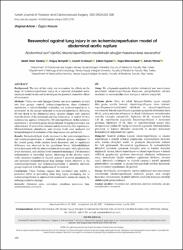| dc.contributor.author | Karakişi, Sedat Ozan | |
| dc.contributor.author | Hemşinli, Doğuş | |
| dc.contributor.author | Tümkaya, Levent | |
| dc.contributor.author | Ergene, Şaban | |
| dc.contributor.author | Mercantepe, Tolga | |
| dc.contributor.author | Yılmaz, Adnan | |
| dc.date.accessioned | 2022-07-27T08:00:28Z | |
| dc.date.available | 2022-07-27T08:00:28Z | |
| dc.date.issued | 2021 | en_US |
| dc.identifier.citation | Karakişi, S. O., Hemşinli, D., Tümkaya, L., Ergene, Ş., Mercantepe, T., & Yılmaz, A. (2021). Resveratrol against lung injury in an ischemia/reperfusion model of abdominal aortic rupture. Turk gogus kalp damar cerrahisi dergisi, 29(3), 330–338. https://doi.org/10.5606/tgkdc.dergisi.2021.21737 | en_US |
| dc.identifier.issn | 1301-5680 | |
| dc.identifier.uri | https://doi.org/10.5606/tgkdc.dergisi.2021.21737 | |
| dc.identifier.uri | https://hdl.handle.net/11436/6272 | |
| dc.description.abstract | Background: The aim of this study was to examine the effects on the lungs of ischemia/reperfusion injury in a ruptured abdominal aortic aneurysm model in rats and to investigate the potential protective effects of resveratrol.
Methods: Thirty-two male Sprague-Dawley rats were randomly divided into four groups: control, ischemia/reperfusion, sham (ischemia/ reperfusion + solvent/dimethyl sulfoxide), and ischemia/reperfusion + resveratrol. In the groups subjected to ischemia/reperfusion, following 60-min shock to the abdominal aorta, vascular clamps were attached from the levels of the infrarenal and iliac bifurcation. A total of 60-min ischemia was applied, followed by 120-min reperfusion. In the ischemia/ reperfusion + resveratrol group, intraperitoneal 10 mg/kg resveratrol was administered 15 min before ischemia and immediately after reperfusion. Malondialdehyde, glutathione, and catalase levels were analyzed and histopathological examination of the lung tissues was performed.
Results: Malondialdehyde levels increased in the ischemia/reperfusion and ischemia/reperfusion + dimethyl sulfoxide groups, compared to the control group, while catalase levels decreased, and no significant difference was observed in the glutathione levels. Malondialdehyde levels decreased with the administration of resveratrol, while glutathione levels increased, and catalase levels remained unchanged. The increased inflammation in interstitial spaces, thickening in the alveolar septal walls, increased numbers of cleaved caspase-3 apoptotic pneumocytes, and increased histopathological lung damage scores observed in the ischemia/reperfusion and ischemia/reperfusion + dimethyl sulfoxide groups improved with the application of resveratrol.
Conclusion: These findings suggest that resveratrol may exhibit a protective effect in preventing acute lung injury developing due to ischemia/reperfusion in ruptured abdominal aortic aneurysm surgery by reducing oxidative damage. | en_US |
| dc.language.iso | eng | en_US |
| dc.publisher | Baycinar Medical Publishing-Bayçınar Tıbbi Yayıncılık | en_US |
| dc.rights | info:eu-repo/semantics/openAccess | en_US |
| dc.subject | Abdominal aorta | en_US |
| dc.subject | Antioxidant | en_US |
| dc.subject | Glutathione peroxidase | en_US |
| dc.subject | Lung | en_US |
| dc.subject | Malondialdehyde | en_US |
| dc.subject | Resveratrol | en_US |
| dc.title | Resveratrol against lung injury in an ischemia/reperfusion model of abdominal aortic rupture | en_US |
| dc.type | article | en_US |
| dc.contributor.department | RTEÜ, Tıp Fakültesi, Cerrahi Tıp Bilimleri Bölümü | en_US |
| dc.contributor.institutionauthor | Karakişi, Hemşinli Doğuş | |
| dc.contributor.institutionauthor | Hemşinli, Doğuş | |
| dc.contributor.institutionauthor | Tümkaya, Levent | |
| dc.contributor.institutionauthor | Ergene, Şaban | |
| dc.contributor.institutionauthor | Mercantepe, Tolga | |
| dc.contributor.institutionauthor | Yılmaz, Adnan | |
| dc.identifier.doi | 10.5606/tgkdc.dergisi.2021.21737 | en_US |
| dc.identifier.volume | 29 | en_US |
| dc.identifier.issue | 3 | en_US |
| dc.identifier.startpage | 330 | en_US |
| dc.identifier.endpage | 338 | en_US |
| dc.relation.journal | Turkish Journal of Thoracic and Cardiovascular Surgery | en_US |
| dc.relation.publicationcategory | Makale - Uluslararası Hakemli Dergi - Kurum Öğretim Elemanı | en_US |


















